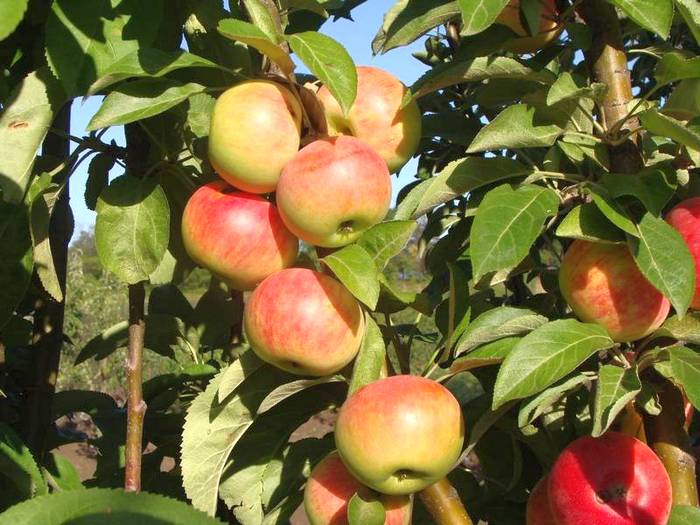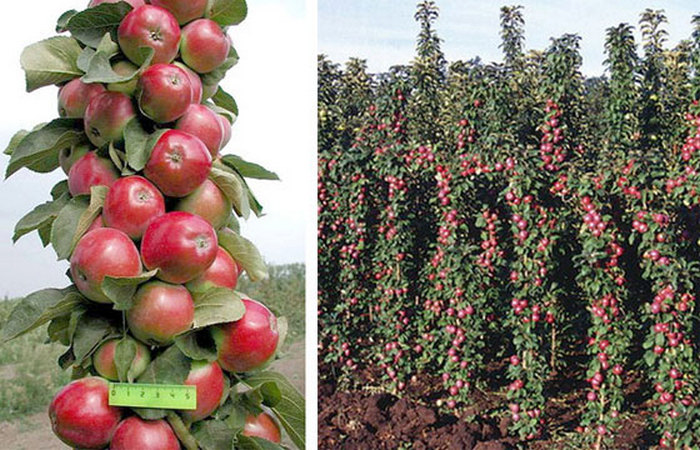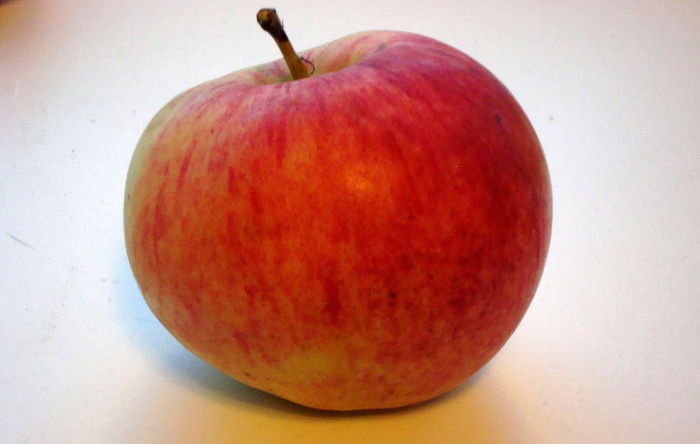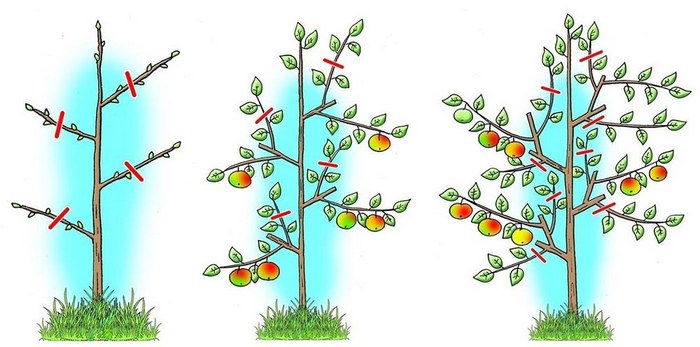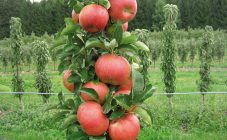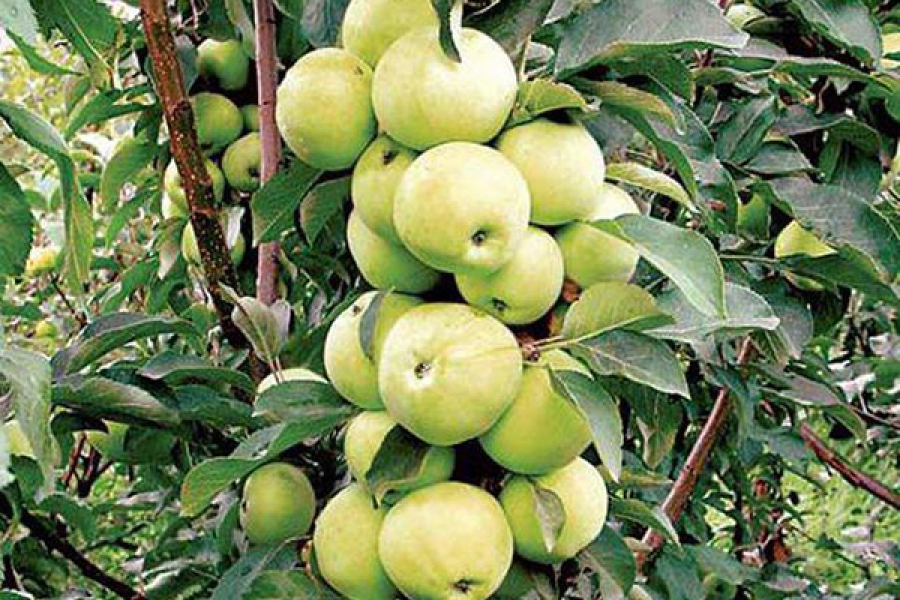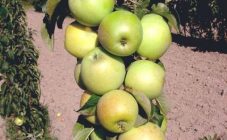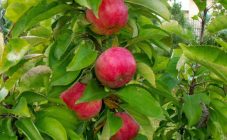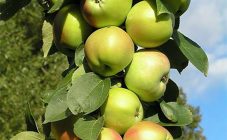Content:
Apples grown in their backyards are tastier and healthier. However, not everyone has large apple orchards. Growing columnar varieties of this fruit tree - miniature and upright growing, can be considered as a way out. One of the most popular representatives of such apple trees is the columnar Gin apple tree.
Culture information
Apple trees, called columnar trees, appeared by chance, thanks to the observation of a Canadian farmer, who noticed an unusual branch on an old apple tree, sprinkled with fragrant small apples. Grafted on the stock, it gave rise to seedlings with a vertical crown.
With seed reproduction, the characteristic features of apple trees are transmitted completely, which made it possible to breed all new varieties of them. In Russia, the variety selection of apple columns was carried out by the scientist V. Kichina. Under his leadership, in 1967, a wonderful variety of columnar autumn apple trees was bred - Jin, which received the working code KV-5. The variety is zoned in the southern regions of Russia, as well as in Ukraine. In the middle lane, the tree also yields, however, it requires protection from frost.
Variety characteristics
Apple trees of this species are characterized by normal winter hardiness and tolerance to a long cold period and daily temperature drops. The tree grows best in warm climatic zones, but with proper shelter and sufficient snow cover, it can successfully develop and bear fruit in colder regions (for example, in the Urals).
The Gin apple tree is characterized by early ripening of the harvest in September, however, it largely depends on climatic conditions, for example, early or late spring.
This variety of apple trees is columnar: on a single dwarf-sized trunk (no higher than two meters) there are several lateral branches that grow at an acute angle upward, so the crown of the tree is very similar to a young cypress. Each year, the height of the tree increases by 0.15-0.2 meters, the trunk is maximum 0.2 meters in diameter in width. A lot of lateral ringlets (small shoots) are formed.
The inside of the trunk is very dense, because a small tree has to withstand a fairly solid weight of ripe apples - about 10-12 kilograms. In general, Jin's yield ranges from 35 to 45 kilograms per apple tree. She begins to bear fruit from the second year after planting a seedling: a one-year-old can give the first 4-5 kilograms of apples, an adult tree is much more productive than ordinary apple trees.
The foliage is usually dark green in color, characteristic of this fruit. The apple tree usually blooms at the end of May, with very beautiful small white flowers, almost all of them form ovaries for future fruits. This variety of columnar apple is self-fertile, however, if there is a pollinator in the form of other apple trees or insects (bees, butterflies), then the yield will be higher, and the fruits will be larger.
The tree bears fruit with medium-sized spherical apples covered with a glossy thin skin. Each ripe apple is colored bright red or crimson with specks, unripe fruits are green.
Universal application: raw (according to tasters, Gin apples deserve 4.7 points), as well as for making:
- freshly squeezed juice and compotes;
- jam, jam, deep fat;
- jam;
- drying and drying;
- baking and decorating dishes;
- alcoholic drinks and cider.
Ripe fruits do not fall from the tree, but wait for the harvest. They are stored in a dark place at the required temperatures for about six months, and they can also be transported over long distances.
The apple orchard of this variety is resistant to scab and other diseases, even with massive damage to neighboring fruit.
Agricultural technology of cultivation
Due to its small size, the Jin columnar apple tree can be planted in one area in large quantities (more than a dozen), according to a very simple placement scheme: the spacing of planting trees is 0.7 meters, the distance between adjacent rows is 0.8 meters.
The prepared seedling is placed in a planting pit, the depth of which is 0.8-1 meter, in the center of which a garter stake is dug in to support the young tree. At the bottom, a slide is made of the earth, along which the roots of the seedling are spread. A hole with a peg and a seedling is covered with removed soil and abundantly spilled with clean water. After sedimentation, it is necessary to supplement it with a new substrate and water it again. It is recommended to mulch the root zone, this will help retain moisture for a long time. In general, during the growing season, watering should be carried out once every three to four days to fully charge the trees with moisture. It is advisable to carry out drip irrigation; to prevent stagnation of moisture, good drainage from expanded clay should be provided.
The Jin apple tree needs timely sanitary pruning of the crown: dried or diseased branches and kolchatka are removed.
The columnar type of apple trees needs to normalize the harvest: in the first year of planting, all flowers are removed so that the tree grows stronger; in the second year, you can leave five or six of the strongest ovaries, then this number increases several times: up to the maximum recommended number of 20 ovaries.
Top dressing of apple trees is carried out several times (three to four) during the growing season, best of all with complex fertilizers.
Advantages and disadvantages of the variety
The apple tree of the columnar type Jin has many positive properties in the description of the variety:
- increased winter hardiness;
- disease resistance, especially scab;
- high yield already in the second year after planting;
- compactness of trees, the possibility of planting a large number of apple trees in a small area;
- simplicity and unpretentiousness in care.
There are also disadvantages, although they are few:
- the need for a strong support peg to withstand the wind;
- the possibility of freezing of the apical bud, the death of which affects the yield;
- superficial root system, which requires additional measures to prevent the tree from drying out;
- the period of active fruiting is limited to one and a half decades.
The characteristic of the columnar Gin apple tree is such that it makes it a favorite of gardeners, especially those with small areas. They prefer to plant it because of the tasty and juicy fruits, which even a child can collect from low trees.
